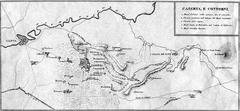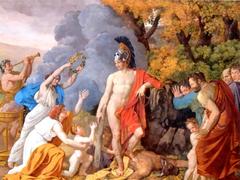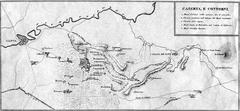
Visiting the Palace of Caserta: Hours, Tickets, History, and Essential Visitor Guide
Date: 14/06/2025
Introduction
The Palace of Caserta (Reggia di Caserta) is one of Italy’s most iconic and grandiose royal residences, constructed in the 18th century to rival Europe’s greatest palaces, including Versailles and Schönbrunn. Designed by the visionary architect Luigi Vanvitelli for King Charles VII of Naples, this UNESCO World Heritage Site boasts over 1,200 rooms, expansive gardens, and remarkable feats of engineering, such as the Carolino Aqueduct. Today, it is a centerpiece of Italian heritage, drawing visitors eager to explore its royal apartments, monumental staircases, lush parklands, and rich cultural history.
Whether you are passionate about European history, architecture, or simply seeking a captivating day trip from Naples or Rome, this comprehensive visitor guide covers everything you need to know: opening hours, ticket prices, tour options, accessibility, and insider tips for making the most of your visit. For official updates and the latest information, consult the Reggia di Caserta Official website.
Table of Contents
- Historical Overview
- Visitor Information
- Main Attractions
- Special Events & Guided Tours
- FAQ – Frequently Asked Questions
- Visitor Tips
- Conclusion
- References
Historical Overview
Origins and Construction
Commissioned in 1752 by Charles VII of Naples (later Charles III of Spain), the Palace of Caserta was envisioned as the administrative and symbolic heart of the Bourbon Kingdom of Naples. Its inland location was strategically chosen for security, away from coastal threats. Architect Luigi Vanvitelli was tasked with creating a residence that would reflect the monarchy’s power and the Enlightenment ideals of rational planning, beauty, and innovation (Visit Naples).
Construction began in 1752 and continued for several decades, with Vanvitelli’s son, Carlo, completing the project after his father’s death. The palace became the largest royal residence in the world by volume, covering 47,000 square meters and incorporating advanced architectural and engineering solutions (Reggia di Caserta Official).
Architectural Significance
The Palace of Caserta is a masterpiece of late Baroque and Neoclassical architecture. Its symmetrical design features four large internal courtyards, a monumental 247-meter façade, and grand interior spaces, including the famous Grand Staircase of Honor and the opulent Throne Room. The palace’s park and gardens, inspired by Versailles, stretch over 120 hectares and are adorned with fountains, cascades, and statues. The English Garden, created later, is one of Italy’s earliest landscape gardens (Visit Italy).
The Carolino Aqueduct, built to supply water to the fountains and gardens, is an 18th-century engineering marvel that remains functional today (Reggia di Caserta Official).
Role in Italian and European History
The palace served as the principal residence of the Bourbon kings and later became significant during the Napoleonic era and World War II. In 1945, it was the site of the German surrender in Italy. In 1997, its architectural and historical importance was recognized through its inscription as a UNESCO World Heritage Site (History Hit).
Visitor Information
Opening Hours
- April–October: 8:30 AM – 7:30 PM (last entry 6:30 PM)
- November–March: 8:30 AM – 5:30 PM (last entry 4:30 PM)
- Closed: Tuesdays, January 1, May 1, December 25
Note: The Royal Park and English Garden may have slightly different hours; the English Garden closes one hour before the park. Always check the official site for up-to-date information.
Tickets and Pricing
- Full ticket (Palace + Park + English Garden): €19 for adults (reggiadicasertaunofficial.it)
- Reduced: €7 for EU citizens aged 18–25
- Free Entry: Children under 18, residents of Caserta, first Sunday of each month, April 25, June 2, November 4
- Audio guides: €5
- Tickets: Strongly recommended to buy online via TicketOne to avoid queues, especially in peak season
How to Get There
- By Train: Caserta train station is directly opposite the palace. Frequent trains from Naples (45 min) and connections from Rome via Naples (nextstop-italy.com).
- By Car: About 30 minutes from Naples; parking available beneath the palace square (myadventuresacrosstheworld.com). Weekends and holidays may have heavy traffic.
- By Bus: Regular buses from Naples Central Bus Station (45 min), followed by a short walk.
- Tours: Many providers offer transport-inclusive packages from Naples or Rome (tiqets.com).
Accessibility and Facilities
- Wheelchair Access: Most palace areas are accessible; wheelchairs available at the ticket office (nomadepicureans.com).
- Restrooms: Located near the ticket office, inside the palace, and throughout the park.
- Luggage Storage: Free storage at the entrance for bags and bulky items (myadventuresacrosstheworld.com).
- Cafés: On-site café for drinks and snacks; picnics allowed in the park (napleswise.com).
- Pets: Only guide and service dogs allowed.
Nearby Attractions
- San Leucio Complex: Historic silk production site (Visit Naples).
- Caserta Old Town: Shops, cafés, and local restaurants.
- Royal Park: Expansive gardens ideal for walks and photography.
Main Attractions
The Royal Apartments
Open to visitors is a curated suite of rooms that showcase regal opulence, including:
- Grand Staircase of Honor: A monumental marble staircase adorned with statues and crowned by a painted dome (Time Travel Turtle).
- Throne Room: Lavishly decorated with gold, frescoes, and chandeliers.
- Private Apartments: Intimate spaces with period furnishings, textiles, and personal art (Pourquoi Pas Nous).
The Park and Gardens
- Central Axis: A 3-kilometer avenue lined with monumental fountains and statues, including the Fountain of Diana and Actaeon, Fountain of Aeolus, and Fountain of Ceres (Pourquoi Pas Nous).
- English Garden: A naturalistic landscape with rare plants, ancient trees, and romantic follies.
- Shuttle Bus: Available for €2.50 roundtrip to reach distant points such as the English Garden (reggiadicasertaunofficial.it).
Art Collections and Decorative Arts
The palace houses an impressive array of paintings, sculptures, tapestries, and original furniture, reflecting the artistic ambitions of the Bourbon dynasty (Pourquoi Pas Nous).
Special Events & Guided Tours
- Events: The palace regularly hosts concerts, art exhibitions, and festivals.
- Guided Tours: Available in multiple languages and highly recommended for in-depth insights. Book in advance during high season (Pourquoi Pas Nous).
- Audio Guides: Available for €5 at the entrance.
FAQ – Frequently Asked Questions
Q: What are the Palace of Caserta’s opening hours?
A: April–October: 8:30 AM–7:30 PM; November–March: 8:30 AM–5:30 PM; closed Tuesdays and some holidays.
Q: How do I buy tickets?
A: Online via TicketOne or at the palace; advance purchase recommended.
Q: Is the palace accessible for those with mobility issues?
A: Yes, most main areas are wheelchair accessible; some garden areas may be more challenging.
Q: Are pets allowed?
A: Only guide and service dogs are permitted.
Q: Can I take photos?
A: Yes, but flash and tripods are typically not allowed.
Q: How much time should I plan for a visit?
A: At least 5–6 hours for the palace and gardens. A full day is ideal.
Q: Are there places to eat?
A: Yes, a café is located in the palace; picnics are allowed in the park.
Visitor Tips
- Best Time to Visit: Spring (April–June) and early autumn for pleasant weather and blooming gardens (myadventuresacrosstheworld.com).
- Plan Your Route: Start with the palace interiors, then explore the park and English Garden.
- Wear Comfortable Shoes: The grounds are extensive.
- Use the Shuttle: Especially if you have limited time or mobility.
Conclusion
The Palace of Caserta is a testament to royal ambition, architectural brilliance, and cultural vitality. Its magnificent interiors, breathtaking gardens, and historical significance make it a must-see destination for anyone visiting southern Italy. Plan your visit using official resources, consider guided tours for a deeper understanding, and don’t miss the chance to explore both the palace and its world-famous parklands.
For the most current information, always check the official website. Download the Audiala app for audio guides and updates, and follow us on social media for travel inspiration and tips.






